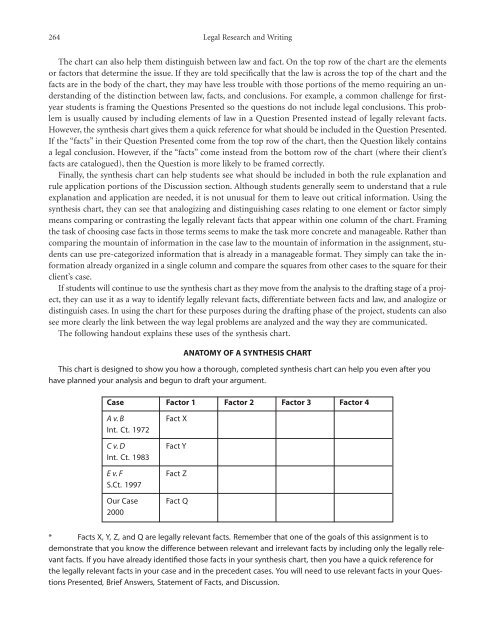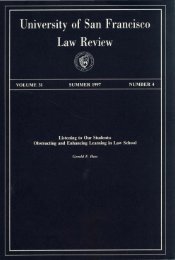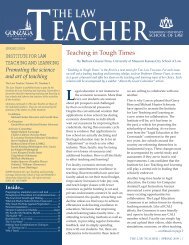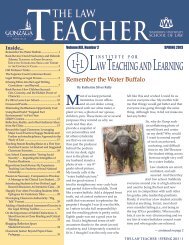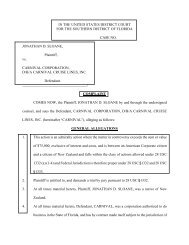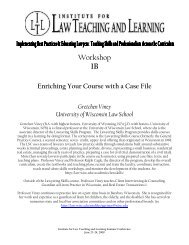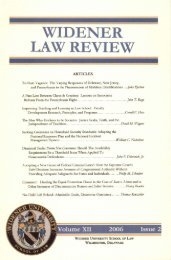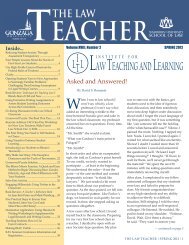Teaching the Law School Curriculum - Institute for Law Teaching ...
Teaching the Law School Curriculum - Institute for Law Teaching ...
Teaching the Law School Curriculum - Institute for Law Teaching ...
You also want an ePaper? Increase the reach of your titles
YUMPU automatically turns print PDFs into web optimized ePapers that Google loves.
264 Legal Research and Writing<br />
The chart can also help <strong>the</strong>m distinguish between law and fact. On <strong>the</strong> top row of <strong>the</strong> chart are <strong>the</strong> elements<br />
or factors that determine <strong>the</strong> issue. If <strong>the</strong>y are told specifically that <strong>the</strong> law is across <strong>the</strong> top of <strong>the</strong> chart and <strong>the</strong><br />
facts are in <strong>the</strong> body of <strong>the</strong> chart, <strong>the</strong>y may have less trouble with those portions of <strong>the</strong> memo requiring an understanding<br />
of <strong>the</strong> distinction between law, facts, and conclusions. For example, a common challenge <strong>for</strong> firstyear<br />
students is framing <strong>the</strong> Questions Presented so <strong>the</strong> questions do not include legal conclusions. This problem<br />
is usually caused by including elements of law in a Question Presented instead of legally relevant facts.<br />
However, <strong>the</strong> syn<strong>the</strong>sis chart gives <strong>the</strong>m a quick reference <strong>for</strong> what should be included in <strong>the</strong> Question Presented.<br />
If <strong>the</strong> “facts” in <strong>the</strong>ir Question Presented come from <strong>the</strong> top row of <strong>the</strong> chart, <strong>the</strong>n <strong>the</strong> Question likely contains<br />
a legal conclusion. However, if <strong>the</strong> “facts” come instead from <strong>the</strong> bottom row of <strong>the</strong> chart (where <strong>the</strong>ir client’s<br />
facts are catalogued), <strong>the</strong>n <strong>the</strong> Question is more likely to be framed correctly.<br />
Finally, <strong>the</strong> syn<strong>the</strong>sis chart can help students see what should be included in both <strong>the</strong> rule explanation and<br />
rule application portions of <strong>the</strong> Discussion section. Although students generally seem to understand that a rule<br />
explanation and application are needed, it is not unusual <strong>for</strong> <strong>the</strong>m to leave out critical in<strong>for</strong>mation. Using <strong>the</strong><br />
syn<strong>the</strong>sis chart, <strong>the</strong>y can see that analogizing and distinguishing cases relating to one element or factor simply<br />
means comparing or contrasting <strong>the</strong> legally relevant facts that appear within one column of <strong>the</strong> chart. Framing<br />
<strong>the</strong> task of choosing case facts in those terms seems to make <strong>the</strong> task more concrete and manageable. Ra<strong>the</strong>r than<br />
comparing <strong>the</strong> mountain of in<strong>for</strong>mation in <strong>the</strong> case law to <strong>the</strong> mountain of in<strong>for</strong>mation in <strong>the</strong> assignment, students<br />
can use pre-categorized in<strong>for</strong>mation that is already in a manageable <strong>for</strong>mat. They simply can take <strong>the</strong> in<strong>for</strong>mation<br />
already organized in a single column and compare <strong>the</strong> squares from o<strong>the</strong>r cases to <strong>the</strong> square <strong>for</strong> <strong>the</strong>ir<br />
client’s case.<br />
If students will continue to use <strong>the</strong> syn<strong>the</strong>sis chart as <strong>the</strong>y move from <strong>the</strong> analysis to <strong>the</strong> drafting stage of a project,<br />
<strong>the</strong>y can use it as a way to identify legally relevant facts, differentiate between facts and law, and analogize or<br />
distinguish cases. In using <strong>the</strong> chart <strong>for</strong> <strong>the</strong>se purposes during <strong>the</strong> drafting phase of <strong>the</strong> project, students can also<br />
see more clearly <strong>the</strong> link between <strong>the</strong> way legal problems are analyzed and <strong>the</strong> way <strong>the</strong>y are communicated.<br />
The following handout explains <strong>the</strong>se uses of <strong>the</strong> syn<strong>the</strong>sis chart.<br />
Case Factor 1 Factor 2 Factor 3 Factor 4<br />
A v. B Fact X<br />
Int. Ct. 1972<br />
C v. D Fact Y<br />
Int. Ct. 1983<br />
E v. F Fact Z<br />
S.Ct. 1997<br />
Our Case Fact Q<br />
2000<br />
ANATOMY OF A SYNTHESIS CHART<br />
This chart is designed to show you how a thorough, completed syn<strong>the</strong>sis chart can help you even after you<br />
have planned your analysis and begun to draft your argument.<br />
* Facts X, Y, Z, and Q are legally relevant facts. Remember that one of <strong>the</strong> goals of this assignment is to<br />
demonstrate that you know <strong>the</strong> difference between relevant and irrelevant facts by including only <strong>the</strong> legally relevant<br />
facts. If you have already identified those facts in your syn<strong>the</strong>sis chart, <strong>the</strong>n you have a quick reference <strong>for</strong><br />
<strong>the</strong> legally relevant facts in your case and in <strong>the</strong> precedent cases. You will need to use relevant facts in your Questions<br />
Presented, Brief Answers, Statement of Facts, and Discussion.


